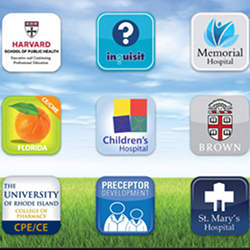
Zoe Youl has taken multitasking to a new level. The 24-year-old registered nurse is working toward a postgraduate certificate in intensive care, while at the same time keeping up with her required 20 hours a year of continuing professional development (CPD). Youl is learning as she walks to work at St. Vincent’s Private Hospital in Melbourne, Australia, or while she is cooking at home, by listening to acute/critical care lectures on her iPhone 5.
The lectures are made available by Ausmed Education, a Melbourne, Australia-based provider of nursing education and CPD content that developed a mobile app called Ausmed-on-the-Go for the iPhone, which offers professional development courses for nurses and midwives. For a $24 (AUD) monthly subscription, users can stream a variety of CPD content and earn credits.
Built into the app is a CPD organizer that “enables me to document and evaluate the lectures that I’ve listened to, which is also a registration requirement,’’ Youl explains. Ausmed “makes the process of finding, completing, evaluating and documenting CPD very easy.”
As people become more accustomed to consuming various types of content wherever they are and whenever they want, observers say Ausmed is onto something by offering professional development resources through a mobile app.
Because of the tools, “the true value you get from investing in mobilizing your workforce is not the same type of application you might have built five years ago,’’ observes Brad Shimmin, service director of Business Technology and Software at market intelligence firm Current Analysis. “A lot of development now is not to mobilize old apps, but to create new solutions that are mobilized” for workers in a variety of industries.
In early 2013, Ausmed noticed an increasing number of nurses were streaming its online lectures via the native web browsers on their mobile phones, says William Egan, chief marketing officer. “To improve the user experience and to align our development goals against user behavior, we decided to create a native app.’’ Ausmed On-the-Go for iOS is the company’s first app, but it soon to be followed by a similar app for Android users.
 Nurses in 29 countries have downloaded the On-the-Go app since January, Egan says.
Nurses in 29 countries have downloaded the On-the-Go app since January, Egan says.
Mobile apps for continuing education are used predominantly in the healthcare industry; most offer access to listings of a provider’s catalog of activities and calendars of upcoming seminars and events, as well as mobile alerts and resources.
“A lot goes into them; a lot of labor and planning so they’re very expensive to build,” notes Gregory Cianfarani, RPh, founder and CEO of RXinsider, a custom builder of mobile applications for professional development in the healthcare, education, and employment fields. Most providers are not yet offering continuing education (CE) content for credit on mobile devices, because building such a custom app could cost around $80,000, he says. “Who can afford to invest in that for one single activity?”
Five years ago, Cianfarani launched CESearchEngine.com, which he describes as a “Google for continuing education,” as it is geared toward finding CE activities across all disciplines.
Cianfarani says that as more people have come to rely on their mobile devices, he knew CE providers would want a mobile app to present their offerings, resources, and online activities. The CESearchEngine.com app points users to what is available and gives users the ability to register for online courses.
Aside from the cost of building a custom app for CE, Cianfarani believes very few people are interested in satisfying continuing education requirements via a mobile phone. “To spend that much time on a phone will drive you crazy; more is done on tablets” and desktops, he contends. He estimates only about 10 percent of the CE market has mobile-enhanced websites.
Egan says he is unaware of the cost to build Ausmed-on-the-Go. He says most nurses use it while they are commuting, walking, or in the car. He has not heard of any drawbacks from streaming the app, other than the resulting increase in data usage and its attendant costs to the user. “To combat this, we stream the lectures at a very low file size. Currently users can only stream audio versions of the lectures, similar to the way podcasts work,” he says. “However, we have received a great deal of requests for video support to be added.”
Shimmin says it seems logical that people would want to listen to lectures for educational purposes, just as they listen to podcasts. “We keep upping ante for the … amount of bandwidth we’re providing users with; in the last couple of years, it has accelerated dramatically, and that changes things.”
Youl likes that the mobile content is kept up to date and is evidence-based, but the learning style is still informal and fits her busy schedule. “All nurses are guilty of using time as a barrier to learn. ” Using a mobile app, she says, “helps breaks down this barrier.”
Esther Shein is a freelance technology and business writer based in the Boston area.



Join the Discussion (0)
Become a Member or Sign In to Post a Comment